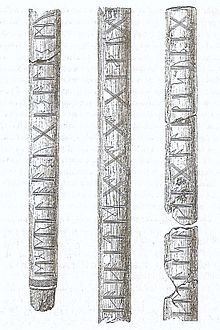Kragehul
The Kragehul is a kessel moor with a 1,500 m² site from the Germanic Iron Age in the center. It is located northwest of Flemløse in Båg Herred, not far from Assens on the island of Funen in Denmark .
The first discoveries were made during peat extraction and published by S. Abildgaard as early as 1761. In the middle of the 19th century , weapons and equipment were found several times . In 1864 a test excavation (40 m²) was carried out by Helvig Conrad Engelhardt (1825–1881), the excavator of the Nydam ship . The last excavations took place in 1876 and 77. Engelhardt published the findings in 1867. They have not been systematically cataloged; some of the older ones were also lost.
Found material and circumstances
Engelhardt lists swords , scabbards and scabbard fittings, including chords and sling swivels. 80 spear and lance tips , an ax , two bows , 20 arrowheads (12 made of iron, 8 made of bone ), plus shaft fragments. A shield boss , iron or bronze fittings and fragments of wood. Utensils such as knives, scissors, tweezers , glass and amber beads and iron pendants. Fragments of horse harness, a " Westland kettle " made of bronze, several wooden vessels and a clay vessel. It can be assumed that the recovered material only makes up part of the sacrifices.
Some older objects were deposited in the open water, because they sank to the lake bed at that time. Iron was preserved in the alkaline environment, whereas textiles and leather perished. The most recent objects were found in a peat-like, acidic environment. As the preservation of wood shows, the objects were not burned before being dumped. Many objects were scattered in layers, but find concentrations could also be recorded.
See also: Conservation conditions for organic material
chronology
The spear and lance tips, as the most important group of finds, are the best source material for the detailed chronological classification of the landfills.
- The oldest is a tip of the Hunn type, which is to be placed at the transition from the older to the younger imperial period . The fragment of a two-layer comb belongs to it.
- The second offering is to be made at the end of period C2. These include lance and spearheads. The Westlandkessel can belong to this or the following resignation.
- The third deposit is assigned to the transition period C3-D1. It contains spearheads, winged chords, swords with hourglass-shaped handles, knobs with animal heads as well as mouthguards and sling swivels with similar decorations and an elongated, pointed oval fire stone.
- Kragehul is particularly known for objects from the period D. This applies to spears and lances which can be attributed to the Germanic Iron Age and which in 30 cases are equipped with entrelac-decorated (braided pattern) shafts. These are U-shaped chords, sword knobs and knife handles with a runic inscription which belongs to the older category.
In addition to the above, objects are known that cannot be assigned to depositions. This applies to the bows and arrowheads, to the ax and to numerous other objects. Despite certain shortcomings, however, a comparison with other bog victims shows the regularity of the Kragehul material. The excavations and analyzes of the bog victims from Illerup Ådal and Ejsbøl showed that the remains are to be interpreted as evidence of several larger landfills. The chronology of the weapons enables the evidence of simultaneous depositions, even with those moor sacrificial sites, the excavation of which was only insufficiently or not at all documented.
Thanks to the evaluation of recent bog victims' sites (from 1950), the fragmentary finds from Kragehul can be assigned to at least four deposits in different epochs. Kragehul coincides geographically and chronologically with the weapon sacrifices in the Little Belt and along the southern Jutland coast.
- The oldest section of Kragehul is around the same time as Vimose 2
- The late part of period C2 includes: part of the finds from Kragehul, the laying down of Ejsbøl-Nord, the late sacrifice of Thorsbjerg, parts of the Nydam material and the Swedish offerings of Skedemosse and Hassle-Bösarp.
- Finally, the Kragehul finds from period D are reminiscent of objects from Nydam.
literature
- Jørgen Ilkjær, Marie Stoklund: Kragehul. In: Reallexikon der Germanischen Altertumskunde (RGA). 2nd Edition. Volume 17, Walter de Gruyter, Berlin / New York 2000, ISBN 3-11-016907-X , pp. 276-281.
- Ingrid Falktoft Anderson: Vejviser til Danmarks oldtid . 1994, ISBN 87-89531-10-8 , p. 215
- J. Ilkjær, J. Lønstrup: The moor find in the valley of the Illerup-Å near Skanderborg in East Jutland (Denmark). Preliminary report. Germania 61, 1983, 95-116.
- J. Ilkjær: Illerup Ådal. The lances and spears In: Jutland arch. Soc. Publ. 25 1.2 1990
annotation
- ↑ Germanic Iron Age, in Denmark from 375 to 750, in Sweden from 400 to 800, is a term used in Scandinavian archeology that, following the generally accepted Roman Empire , replaces the terms migration period and early Middle Ages used in continental Europe . In Sweden, for example, the Germanic Iron Age includes the Vendel period .
Web links
- Description Danish (PDF; 704 kB)
- Description Danish and picture
Coordinates: 55 ° 15 ′ 37 ″ N , 10 ° 3 ′ 51 ″ E
